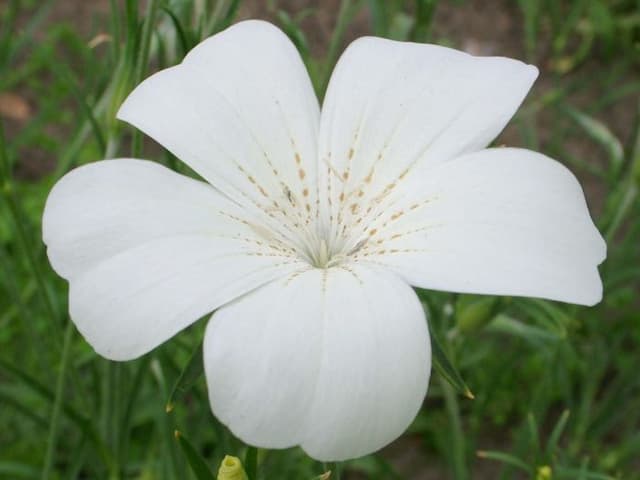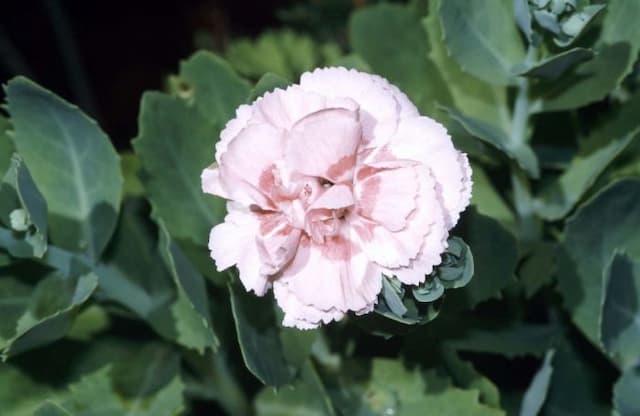Carnation Dianthus 'Natalie Saunders' (b)

ABOUT
Dianthus 'Natalie Saunders' is a type of flower commonly known as pinks due to their frilled or pinked margins on the petals, though this notation does not relate to the actual color of the flowers. This particular variety is recognized for its beautiful blooms that exhibit a rich color palette. The flowers are typically a vibrant shade and can feature a striking contrast with a different hue at their petal edges or centers, creating an eye-catching display. The plant produces a generous number of blossoms that are structured with a dense cluster of petals in each bloom. These petals have a notable texture, often appearing slightly ruffled or fringed, contributing to the ornamental quality of the flower head. The foliage of Dianthus 'Natalie Saunders' consists of slender leaves that have a narrow and elongated profile. Leaves often feature a blue-green to grayish-green color, which forms an attractive backdrop for the bright hues of the flowers. This striking combination of foliage and blooms makes the plant an appealing addition to any garden setting where a pop of color is desired. The plant has a compact, mounded growth habit, forming tufts of foliage from which the flower stems emerge. When in bloom, 'Natalie Saunders' can catch the eye with its showy display, and it often emanates a delightful, sweet fragrance which can be quite noticeable when in close proximity. The scent can add another layer of enjoyment to the garden experience beyond the visual splendor of the flowers. Overall, Dianthus 'Natalie Saunders' is a showy and fragrant plant that is enjoyed for its decorative blooms and pleasant aroma, enhancing its appeal in ornamental gardens.
About this plant
 Names
NamesFamily
Caryophyllaceae
Synonyms
Natalie Saunders Carnation, Natalie Saunders Pink
Common names
Dianthus 'Natalie Saunders'.
 Toxicity
ToxicityTo humans
Dianthus, commonly known as "pinks," is not considered toxic to humans. These plants are generally recognized as safe, and there are no commonly reported symptoms of poisoning from ingestion of Dianthus species. However, as with any plant material, individual allergies and reactions can occur, so it's advisable to avoid ingesting parts of the plant unless it is known to be edible.
To pets
Dianthus, commonly known as "pinks," is also not considered toxic to pets. It is not known to cause poisoning in animals such as dogs and cats. Therefore, ingestion of Dianthus typically does not lead to any severe symptoms or consequences. However, individual animals might have sensitivities, and ingestion could possibly cause mild gastrointestinal upset in some cases.
 Characteristics
CharacteristicsLife cycle
Perennials
Foliage type
Evergreen
Color of leaves
Blue-green
Flower color
Pink
Height
1 foot (30 centimeters)
Spread
1 foot (30 centimeters)
Plant type
Herb
Hardiness zones
3
Native area
Europe
Benefits
 General Benefits
General Benefits- Attractive Flowers - Dianthus 'Natalie Saunders' features beautiful, colorful blooms that add visual interest to any garden or landscape.
- Long Blooming Period - This cultivar typically has a longer flowering season, providing color for an extended period.
- Drought Tolerance - Once established, dianthus plants have a good tolerance to dry conditions, requiring less water than many other plants.
- Low Maintenance - Dianthus 'Natalie Saunders' is generally easy to care for, requiring minimal upkeep beyond basic watering and occasional fertilization.
- Fragrance - The blooms of many Dianthus species are known for their sweet fragrance, which can add a pleasant scent to gardens and outdoor areas.
- Pest Resistance - These plants are typically resistant to many common garden pests, reducing the need for chemical control measures.
- Attracts Pollinators - The colorful and fragrant flowers can attract pollinators such as bees and butterflies, supporting local ecosystems.
- Versatility - Suitable for planting in flower beds, borders, rock gardens, and containers, adding versatility to landscaping options.
 Medical Properties
Medical PropertiesThis plant is not used for medical purposes.
 Air-purifying Qualities
Air-purifying QualitiesThis plant is not specifically known for air purifying qualities.
 Other Uses
Other Uses- Edging for paths and walkways: The compact growth habit of the Dianthus 'Natalie Saunders' makes it suitable for creating neat, decorative edges along garden paths and walkway borders.
- Container gardening: Due to their moderate size and vibrant colors, these plants can be used to add visual interest to patio pots, window boxes, or hanging baskets.
- Pressed flower crafts: The distinct and colorful petals of Dianthus can be pressed and used for making bookmarks, greeting cards, or other decorative crafts.
- Natural fabric dye: The petals contain pigments that can be used to create a natural dye for fabrics, producing a range of soft pink to vibrant magenta hues.
- Ice cube adornments: Petals of Dianthus can be frozen in ice cubes to add a touch of elegance to cold beverages during special events or parties.
- Garnish for culinary dishes: The non-toxic petals can be used as a colorful garnish for salads, desserts, or cocktails, enhancing the visual appeal of the food.
- Scented sachets: Dried Dianthus flowers can be placed in sachets to impart their fragrance in drawers, closets, or small rooms.
- Homemade potpourri: The dried flowers can be mixed with other dried botanicals and spices to create a potpourri blend for freshening indoor air.
- Floral crowns or boutonnieres: Dianthus flowers can be used to create floral crowns for festivals, weddings, or as boutonnieres for formal occasions.
- Photography prop: The attractive shapes and colors of Dianthus blooms make them excellent subjects or props for still life and macro photography.
Interesting Facts
 Feng Shui
Feng ShuiThe Dianthus, also known as Carnation, can be used in Feng Shui to promote love, healing, and energy protection. They can be placed in the love and marriage area of the home to strengthen relationships or in personal spaces for increased healing energy.
 Zodiac Sign Compitability
Zodiac Sign CompitabilityThe Carnation is not used in astrology practice.
 Plant Symbolism
Plant Symbolism- Love: Dianthus flowers, commonly known as "carnations," often symbolize love and fascination. The intricate petals and sweet fragrance of the Dianthus 'Natalie Saunders' may represent deep romantic feelings and affection.
- Distinction: The unique and vibrant appearance of Dianthus 'Natalie Saunders' can symbolize the desire to stand out and be distinctive or unique.
- Divine Love: In Christian symbolism, the carnation is sometimes associated with divine love, representing the love of God as shown through the incarnation of Jesus.
- Femininity: The soft, frilled petals of the Dianthus 'Natalie Saunders' might exemplify the virtues of femininity, such as grace, gentleness, and emotional depth.
 Water
WaterCarnations, including Dianthus 'Natalie Saunders', prefer their soil to be consistently moist but not waterlogged. During active growth in the spring and summer, water thoroughly whenever the top inch of soil feels dry to the touch, which may be approximately once a week, depending on climate and weather conditions. Each watering session should provide enough water to moisten the soil to a depth of at least 6 inches, translating to about 1-2 gallons for a standard outdoor garden plant. Reduce watering frequency in the fall and winter when the plant's growth slows down, ensuring the soil doesn't remain soggy to prevent root rot. Always use a watering can or a hose with a gentle spray to avoid damaging the plant's delicate foliage and flowers.
 Light
LightCarnations thrive best in full sun, receiving at least six hours of direct sunlight daily. These plants will benefit from being placed in a location that ensures an abundance of light without being shaded by larger plants or structures, as sufficient sunlight is crucial for their robust growth and vibrant flowering. However, in very hot climates, a little afternoon shade can help protect the flowers from intense, potentially damaging heat.
 Temperature
TemperatureCarnations prefer temperate conditions and can handle a range from roughly 40 to 85 degrees Fahrenheit. They can survive occasional dips just below freezing, but prolonged exposure to temperatures under 40 degrees Fahrenheit can be harmful to the plant. The ideal growing temperature range for Carnations is between 60 and 70 degrees Fahrenheit, which promotes healthy growth and abundant flowering.
 Pruning
PruningPruning Carnations is essential for promoting bushier growth, encouraging more blooms, and maintaining the plant's shape. Deadhead spent flowers regularly to encourage new blooms. Conduct a more thorough pruning in early spring or late fall by cutting back the stems to about one-third of their length, which helps to invigorate new growth and improve air circulation. The best time to prune significantly is in the spring, just before new growth starts.
 Cleaning
CleaningAs needed
 Soil
SoilCarnations prefer well-draining, loamy to sandy soil with a pH of 6.0 to 7.5. A good soil mix for carnations is one part garden soil, one part compost, and one part perlite or sand to enhance drainage.
 Repotting
RepottingCarnations should be repotted every 2 to 3 years or when they outgrow their current container. Ensure each repotting session provides fresh soil to support continued growth.
 Humidity & Misting
Humidity & MistingCarnations thrive best in moderate humidity conditions, generally around 40-50%, but are adaptable to lower humidity levels commonly found in home environments.
 Suitable locations
Suitable locationsIndoor
Place in a bright spot, avoid excessive heat, and ensure good soil drainage.
Outdoor
Full sun, shelter from strong winds, well-draining soil, water when dry.
Hardiness zone
4-9 USDA
 Life cycle
Life cycleThe life of Dianthus 'Natalie Saunders,' commonly known as carnation or pink, begins with seed germination, typically in early spring when the soil is moist and temperatures are moderate. Following germination, the plant enters the vegetative stage, developing a rosette of leaves at the soil surface and establishing a strong root system. As it matures and environmental conditions become favorable, usually in late spring to early summer, the carnation enters the flowering stage, producing distinctive pink to red blossoms with a frilled or serrated petal edge. After pollination, often by insects attracted to the flowers' fragrance and nectar, the plant produces seeds in a capsule, completing the reproductive stage. If conditions are suitable, Dianthus 'Natalie Saunders' may bloom again in the same season, exhibiting a perennial habit. Over winter, the plant will typically go dormant, with above-ground growth dying back, but the root system remains alive to regenerate new growth in the following spring.
 Propogation
PropogationPropogation time
Early spring
The most popular method of propagation for the Dianthus 'Natalie Saunders', commonly known as a type of Carnation or Pink, is through cuttings. This is typically done in late spring to early summer. To propagate Carnations via cuttings, select a healthy, non-flowering stem and cut a 4 to 6-inch piece, making sure there are at least three nodes present. The bottom leaves are removed and the cut end is dipped in rooting hormone to encourage root growth. The cutting is then planted in a moist, well-draining potting mix, with the lower nodes buried where roots will form. The pot should be kept in a warm, bright spot but out of direct sunlight, and the soil should be kept consistently moist but not waterlogged. Roots usually develop within two to three weeks, after which the new Carnation plant can eventually be transplanted outdoors.








![Pink [Bubblegum]](/_next/image?url=https%3A%2F%2Fplants-admin.emdemapps.com%2Fimages%2Fplants%2F%2Fimages%2F604b596f31cbb.png&w=640&q=75)
